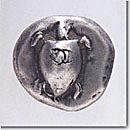|
The island of Aegina was the first region of the Greek mainland that minted silver coins, the staters, in ca. 575 BC. The turtle and later the tortoise were chosen as symbols for the first mintings. The silver used for the first coins of Aegina came either from the Laurium mines, or from Sifnos. This initiative is probably associated with the fact that, since the island was the only Greek presence in the foundation of the trade community of Naucratis on the Nile Delta, the Aeginetans had got in touch with the peoples of the East and mainly with the Lydians, who invented coinage.
|
 |













